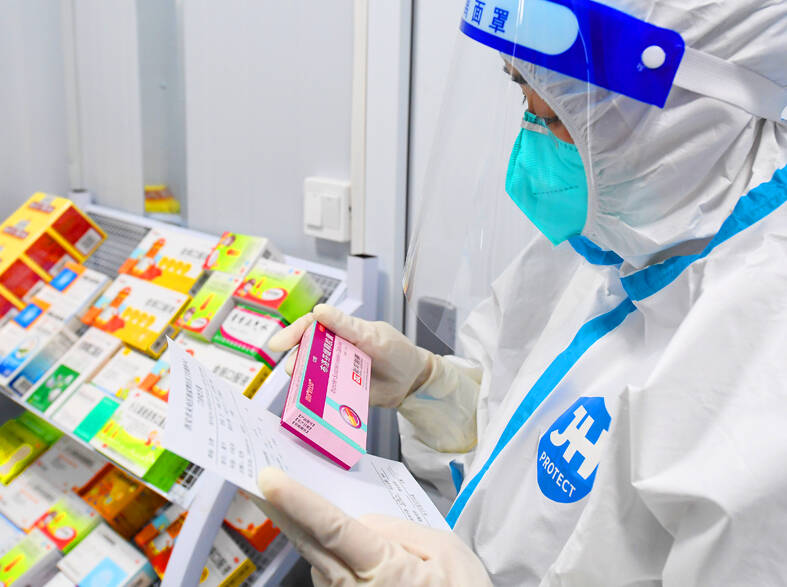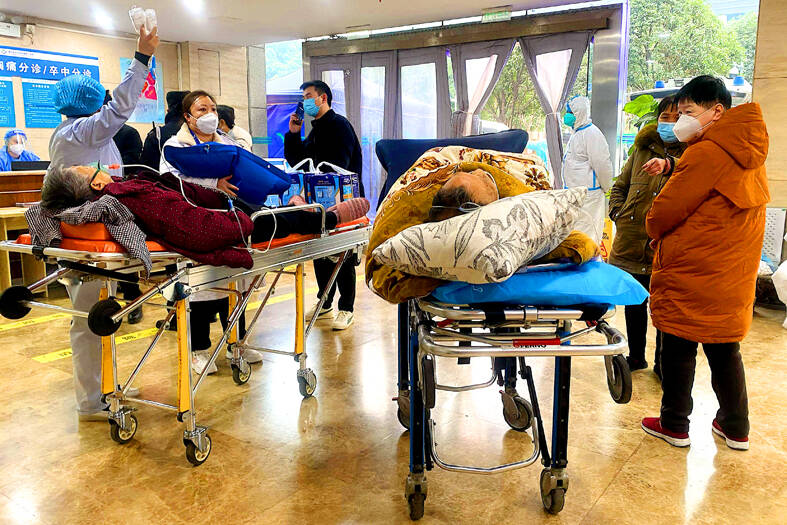China is likely experiencing 1 million new COVID-19 cases and 5,000 deaths from the virus every day, as it grapples with what is expected to be the biggest outbreak of the disease the world has ever seen, a new analysis showed.
However, the situation could get even worse for the country of 1.4 billion people.
The number of daily cases might rise to 3.7 million next month, UK-based Airfinity Ltd said.

Photo: EPA-EFE / XINHUA / ZOU JINGYI
There would likely be another surge of cases that would push the daily peak to 4.2 million in March, the analytics company said.
Its modeling of the scale and toll of China’s outbreak, which uses provincial data, showed that the impact of the country’s abrupt pivot away from its “zero COVID-19” policy far exceeds the Chinese government’s tally.
Officially, China reported 2,966 new cases on Wednesday.

Photo: AFP
There have been fewer than 10 officially recognized COVID-19 deaths since the beginning of this month.
However, that contrasts with a growing chorus of reports that hospitals are being overwhelmed with patients and crematoriums are being pushed well beyond their capacity.
Changes to how the government reports virus figures is also a factor. China has largely shut down its vast network of mass-testing booths and scrapped efforts to include every single infection in the daily tally, leaving residents to rely on rapid tests with no obligation to report the results.
The country’s health regulator also quietly adopted a narrower definition for what is considered a COVID-19 death — and much more selective than what many Western nations use — making it difficult to gauge the real toll from the deluge of infections.
These changes mean “the official data is unlikely to be a true reflection of the outbreak being experienced across the country,” Airfinity vaccines and epidemiology head Louise Blair said in a statement. “This change could downplay the extent of deaths seen in China.”
Accurately capturing the COVID-19 situation remains difficult across the world, as a pivot to living with the virus means fewer countries test frequently.
The emergence last year of the highly transmissible Omicron variant of SARS-CoV-2 sparked a jump in infections, including in the US, which posted its highest daily case count to date at nearly 1.4 million infections in January.
That coincided with the global number exceeding 4 million, Our World in Data figures showed.

People can preregister to receive their NT$10,000 (US$325) cash distributed from the central government on Nov. 5 after President William Lai (賴清德) yesterday signed the Special Budget for Strengthening Economic, Social and National Security Resilience, the Executive Yuan told a news conference last night. The special budget, passed by the Legislative Yuan on Friday last week with a cash handout budget of NT$236 billion, was officially submitted to the Executive Yuan and the Presidential Office yesterday afternoon. People can register through the official Web site at https://10000.gov.tw to have the funds deposited into their bank accounts, withdraw the funds at automated teller

PEACE AND STABILITY: Maintaining the cross-strait ‘status quo’ has long been the government’s position, the Ministry of Foreign Affairs said Taiwan is committed to maintaining the cross-strait “status quo” and seeks no escalation of tensions, the Ministry of Foreign Affairs (MOFA) said yesterday, rebutting a Time magazine opinion piece that described President William Lai (賴清德) as a “reckless leader.” The article, titled “The US Must Beware of Taiwan’s Reckless Leader,” was written by Lyle Goldstein, director of the Asia Program at the Washington-based Defense Priorities think tank. Goldstein wrote that Taiwan is “the world’s most dangerous flashpoint” amid ongoing conflicts in the Middle East and Russia’s invasion of Ukraine. He said that the situation in the Taiwan Strait has become less stable

CONCESSION: A Shin Kong official said that the firm was ‘willing to contribute’ to the nation, as the move would enable Nvidia Crop to build its headquarters in Taiwan Shin Kong Life Insurance Co (新光人壽) yesterday said it would relinquish land-use rights, or known as surface rights, for two plots in Taipei’s Beitou District (北投), paving the way for Nvidia Corp to expand its office footprint in Taiwan. The insurer said it made the decision “in the interest of the nation’s greater good” and would not seek compensation from taxpayers for potential future losses, calling the move a gesture to resolve a months-long impasse among the insurer, the Taipei City Government and the US chip giant. “The decision was made on the condition that the Taipei City Government reimburses the related

FRESH LOOK: A committee would gather expert and public input on the themes and visual motifs that would appear on the notes, the central bank governor said The central bank has launched a comprehensive redesign of New Taiwan dollar banknotes to enhance anti-counterfeiting measures, improve accessibility and align the bills with global sustainability standards, Governor Yang Chin-long (楊金龍) told a meeting of the legislature’s Finance Committee yesterday. The overhaul would affect all five denominations — NT$100, NT$200, NT$500, NT$1,000 and NT$2,000 notes — but not coins, Yang said. It would be the first major update to the banknotes in 24 years, as the current series, introduced in 2001, has remained in circulation amid rapid advances in printing technology and security standards. “Updating the notes is essential to safeguard the integrity